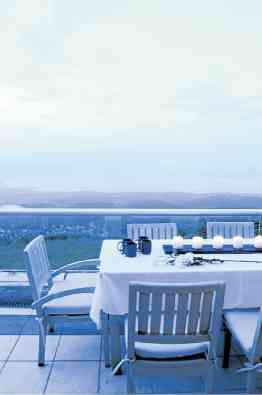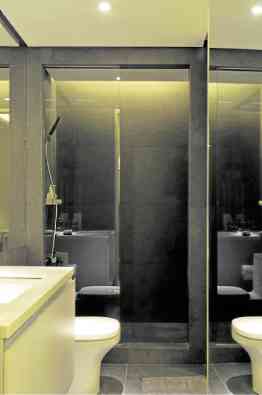Designing for everyday pleasure

The pleasure of seeing art from this sliver of a window, bringing texture, color and movement to this quiet space.
What do you indulge in while you spend your days at home?
As we continue to navigate uncertainties, I’m sure we’re all keeping our guard up and making sure we give ourselves some TLC. The discomfort we are experiencing drives us to find ways of enhancing the quality and pace of our lives, those everyday patterns and routines that have been disrupted, derailed and slowed, due to circumstances beyond our control. We compensate by granting ourselves reasonable doses of pleasurable activities and experiences, in the hope that they lift our spirits.
After all, pleasure takes the distress away, sweeps it under the carpet and gives us some relief, providing temporary bliss. Our source of these gratifying and pleasurable moments need not be lofty, mind-altering or riveting. Sometimes, even just a funny movie is all we need.
In the tangible world, the pleasures we enjoy come in a wide assortment and we indulge in them through our own unique and individual ways. For some, their pleasures are simple—reading a book, watching the sunrise or having a great meal. For others, it means being in a club with dance music, or taking a fancy car to run at high speed. For others yet, it’s as basic as a good night’s sleep. To each his own fix, so to speak.

When visual pleasures call out to us, like textural fabrics on a soft bed, evoking warmth and comfort.
Each day, our eyes are the recipients of multiple doses of pleasure. What they allow us to enjoy are incredible: from the burning skies at sunset, or the monumental and imposing structures that we come face-to-face with in our everyday urban experience, to the little details like the pattern on the fabric of our sofa, or the finely-crafted hardware of our handbag.
What we see can be suggestive of luxury and softness, or rugged informality. It can also express bodily comfort or temperature: the shiny cold of a glazed surface against the warmth of a soft textural one. As our visual faculties call us to take a step further, we are prompted to explore these things with our hands, making concrete connections by touching and feeling.
When visual pleasures call out to us—like when seeing a beautifully waxed wooden table—our instincts tell us to run our hands along its surface to feel the smoothness that our eyes have promised. As we do so, we elevate our experience from merely visual to tactile.
I remember a retailer friend telling me that when a shopper picks up an item from the display in order to feel it, it’s a 99 percent guarantee that he or she will make the purchase. Understanding what emotions our visual cues incite allows us to distinguish what we would like to keep around us. It is often the basis for our choices.
Taking that further, there is the everyday pleasure of bodily comfort that ergonomics and anthropometrics enable. When our body dimensions are appropriately applied to a design, we are able to sit, rest or perform an activity with functional support and a large degree of ease. Small movements like opening a drawer or flipping a cabinet door all contribute to the experience of having our immediate environments collaborate in our tasks and allow us to perform at our optimum. When we experience this “made to measure fitness of things,” we integrate with the objects around us as if we were part of them, and they, as if extensions of our bodies.
But sometimes, we just wallow in our spaces for the sheer enjoyment of the transitions brought by movement itself. Navigating from void to void when traversing rooms should be a choreographed experience, pausing at spots that allow us to appreciate certain focal points like a beautiful artwork or a window with a great view, both which are visually attractive and pleasurable. When the series of spaces are tailored to our activities and provide visual cues and momentary stimulation, they work to enhance the quality of the transitions, prompting inspiration, energy and vitality. It’s such a simple approach, but a vital one at a time when activities are limited.
But there are those pleasures we are forcibly deprived of these days, like the excitement of being in a public place, where the delights are entirely different. Because their scale is more imposing and grand, we enjoy spaciousness and expanse, feeling small and seeing things from a wider vantage point. Aside from the satisfaction we derive from navigating its spaces, public structures provide us the gratification of feeling like we are part of its rationale for existing.
Museums, for example, have an uncanny way of changing our demeanor as we meander through them, making us quiet and observant. And because they are of cultural significance and historical value, we take pleasure in having elevated our own significance simply by patronizing their spaces. It is as if we are part of the legacy they protect.

Bring your activity out to where you can immerse in views and indulge in the pleasure of the outdoors, be it a balcony, a garden, or even right by your window.
Social spaces like restaurants, bars and even places of worship give us the pleasure of interaction, whereby the sights, sounds and provisions, prompt us to connect with other people, giving us a sense of belonging. We derive pleasure from experiencing common interests in a space that supports our activities and experiential preferences. We can come together to create memorable moments.
When I think about designing for pleasure, I remember one of the key points author Robert Fulghum notes in his classic book “All I Really Need to Know I Learned in Kindergarten,” and that is, to “be aware of wonder.” Being at home every day gives us the chance to have a greater appreciation for our immediate surroundings, the spaces and the objects we choose to keep. We do, after all, create our spaces with our very own pleasure in mind.
As the home became the epicenter of our daily living, we have to be mindful of its amazing offerings. And if we can’t find them, then it’s time to create them.

